Salix spp.
When most people think of a willow tree, a vivid image of grace and elegance often comes to mind.
The willow is renowned for its distinct features that evoke a sense of enchantment and tranquility.

We link to vendors to help you find relevant products. If you buy from one of our links, we may earn a commission.
Salix is a genus of shrubs and trees belonging to the willow family, Salicaceae. Growing in an abundance of shapes and sizes, it includes approximately 400 species worldwide.
Willows are a sight to behold with their graceful swaying in the wind, lush foliage, and deep roots that connect to the earth.
Mostly native to cold and temperate areas, these trees are valued for ornamental, shading, timber, medicine, and erosion control needs.
As you continue to read below, exploring our comprehensive guide to growing and nurturing these enchanting trees, you will unveil the secrets of willow cultivation.
Here is what to expect next:
What You’ll Learn
Cultivation and History
A group that includes many different species, willow trees can be found throughout the world.
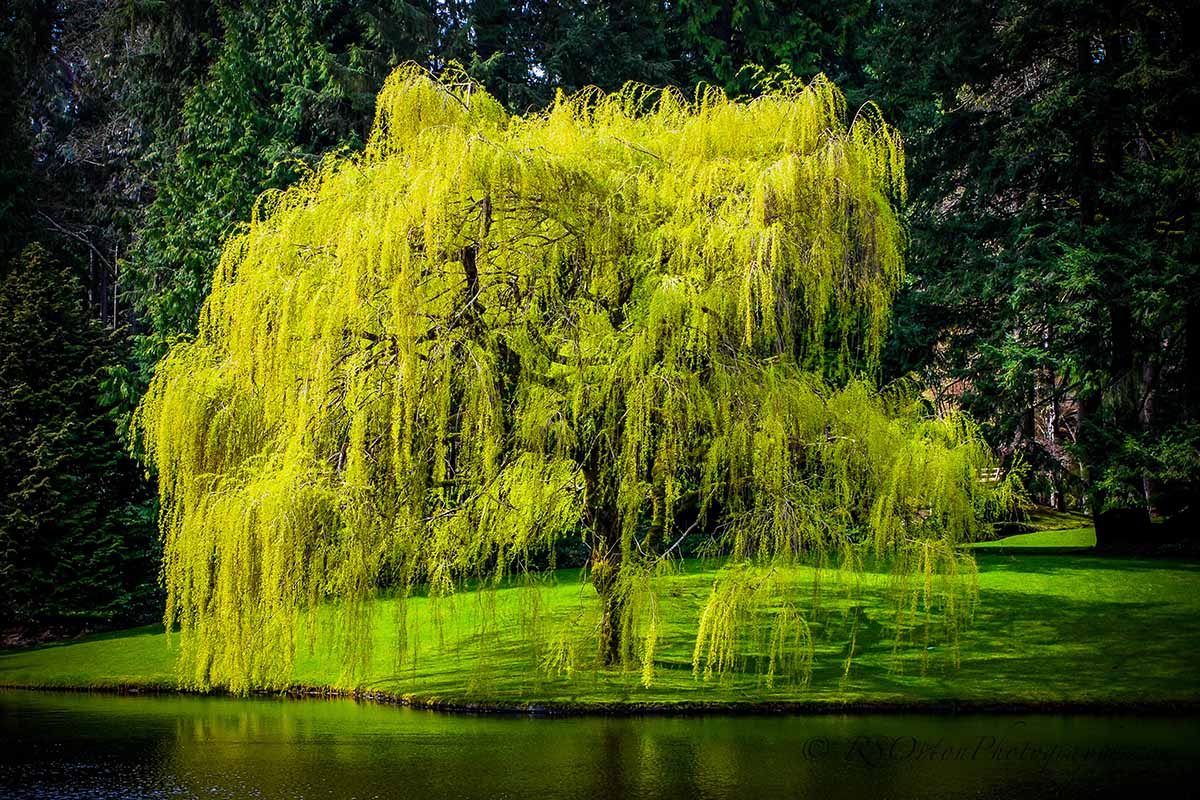
The ancient Egyptians were among the first to recognize the medicinal properties of the weeping willow (S. babylonica).
It may surprise you, but willow bark has a history of being used in traditional medicine for more than 3,500 years. The bark and leaves contain a chemical compound known as salicin.
Although unknown to the Sumerians and Egyptians who used willow for its analgesic and anti-inflammatory effects in their time, the natural compound salicin discovered in 1828 would be used as the precursor of aspirin in 1897.
Scientific evidence for using willow to relieve pain and as a fever reducer first surfaced in 1862.
In 1862, an American trader named Edwin Smith in Cairo purchased some ancient scrolls dating back to around 1500 BCE.

These scrolls are known as the Edwin Smith Surgical Papyrus and the Ebers Papyrus and within these scrolls was the first written record of the use of Salix in treating pain.
The rich herbal knowledge of willow transcended the rise and fall of empires and was revived in ancient Greece.
Willow was recommended by Hippocrates to relieve the pain of childbirth.
This recommendation persisted beyond the time of Hippocrates and continued to be utilized during the Roman era as well. Recorded by Pliny the Elder, white willow (S. alba) was mentioned as one of the oldest painkillers in human history.
Chinese physicians have been using white willow since 500 BCE to lower fevers and relieve pain.
Alongside Assyrians, Egyptians, and Greeks, Native American tribes, including the Cherokee, Blackfoot, Iroquois, and Inuit people, used it for various ailments, including rheumatism and general pain.
In the mid-1700s, white willow was used in Britain as a remedy for malaria.
Willow would go on to be mentioned in different writings throughout time, with documented use in treating various ailments.
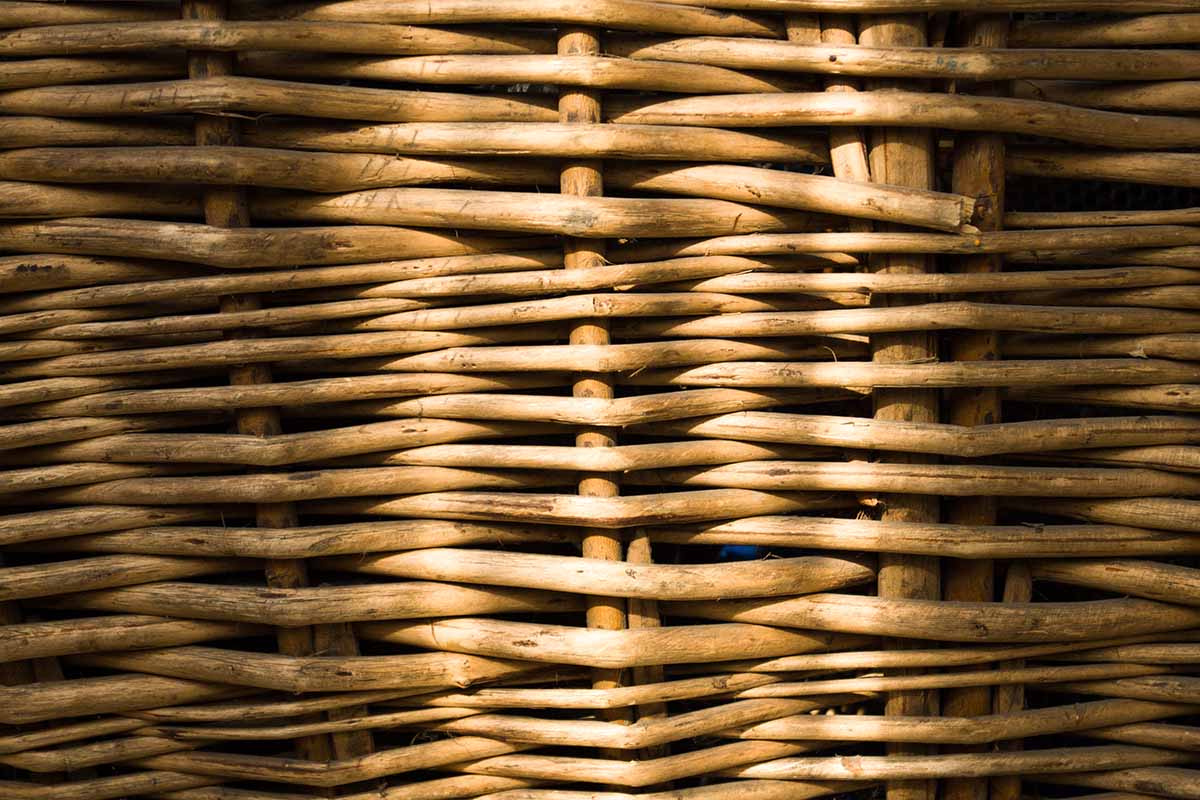
Along with its medicinal properties, the wood has been used for making paint brushes, fishing nets, traps, fences, whistles, furniture, brooms, basketry, and so much more.
Willow Tree Propagation
The propagation techniques that I will cover below are those readily available to home gardeners.
If you are considering grafting, consult with experienced grafters, horticulturists, or arborists with experience in grafting these trees specifically.
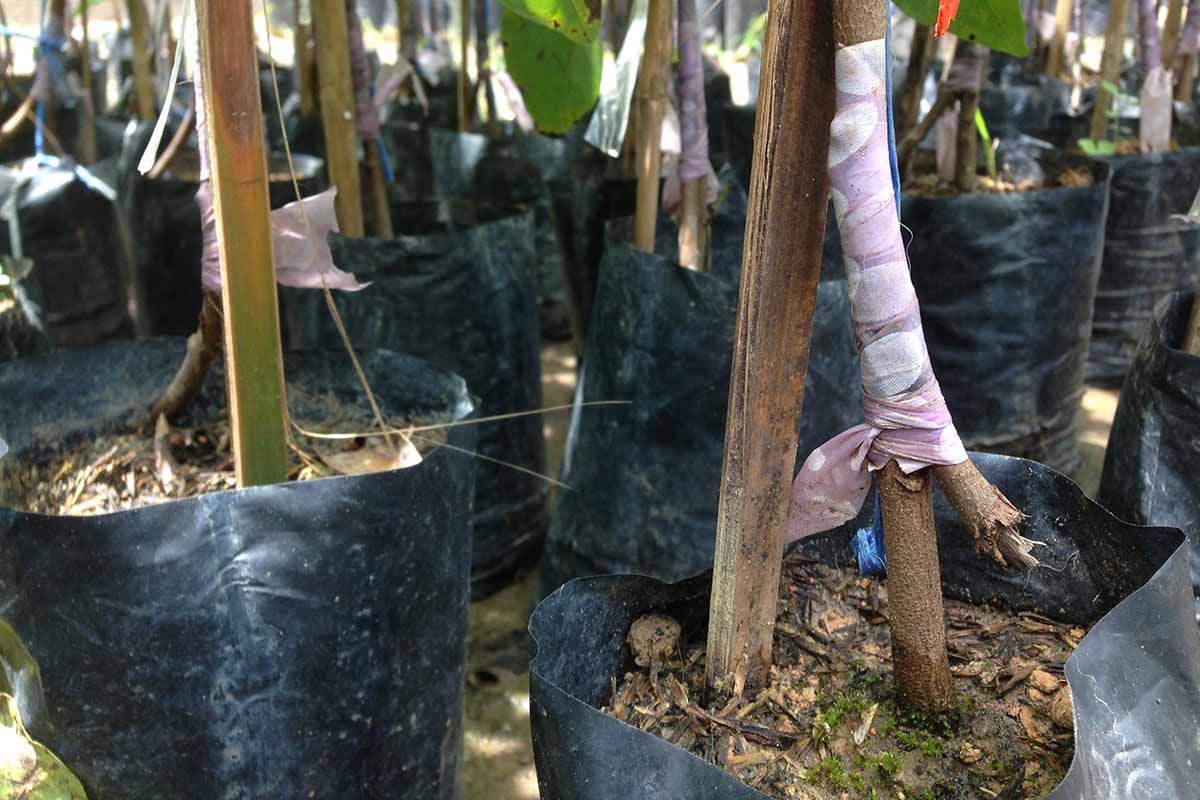
They can guide you in selecting appropriate rootstocks and proper grafting techniques to be successful.
As a side note, If you are anything like me, a spontaneous experimenter, you can always be a little hardheaded, dive in headfirst, and hope and wish everything goes well.
If you look at life from my point of view, having a list of failed attempts could season you into becoming a master gardener! Like me, you will learn from what not to do first.
If you are not like me and want to ensure the proper execution of the grafting process on your first try, always remember that help is not far away.
Reach out to a local extension master gardener in your area.
Now, let’s get to it:
From Seed
Willows produce seeds that can be used for propagation. You will see that most people like to propagate these trees via cuttings, but that doesn’t mean seed propagation can’t be done.
The seeds are very fluffy and light, which makes it easy for them to be distributed by the wind. But being so light makes it harder for them to be collected, since there are no nuts or large berries to pull from a tree for easy access.
Plan to collect seeds in late May or June, before they have all blown away.
Vacuum cleaners have been used at times for this very process. I can’t help but wonder about the first person who had that sudden light bulb pop over their head with this idea.
Alternatively, if the vacuum process is a bit weird for you, like it is for me, around the same time in May or June, you can acquire a small branch or two and release the seeds yourself.
It’s important to note that while the general seed-sowing process remains similar across different species, there can be variations in the specific requirements and characteristics of each variety.
Let’s use pussy willow (S. discolor) for our example. It is easy to grow this plant from seed by collecting seeds from the catkins, and you will do this when they look to be the most cottony.

Indoors, fill small containers or a seed-starting tray with potting mix and immediately sow the seeds on the surface of the soil with the silky seed hairs still attached.
Keep the soil in the container evenly moist until the seeds have germinated.
After germination, place the container in a sunny location and continue to provide even moisture for the seedlings as they grow.
Once these seedlings have reached a height of six to 12 inches and have several sets of well-developed leaves and established healthy root systems, they are ready to be transplanted into your landscape.
The exact timing for transplantation depends on the growth rate of your specific variety.
Some Salix species may have specific seed dormancy requirements or exhibit lower germination rates than other varieties. Some examples may include the need for cold stratification or simple soaking in water.
Research the particular germination requirements for the species you intend to grow. Ensure also to check the specifics for sunlight, moisture levels, soil type, and other environmental preferences.
From Cuttings
Almost all willows will root from cuttings. You can take fresh cuttings during spring or early summer as well as dormant cuttings in the winter.
For dormant cuttings you can soak them in water for 24 to 48 hours or use a rooting hormone solution to stimulate root development.
While both cuttings have potential to grow, fresh cuttings will generally have a higher success rate than dormant ones.
Willow trees are generally some of the easiest plants to root. The hormones they contain encourages this rapid rooting process. It is so rapid that other plants can benefit from a rooting solution made by boiling willow stems in water.
Remember this when thinking of growing other plants. I’ll happily accept your thank-yous with plant offerings when you have too many successful plants on your hands!
Take a cutting 12 to 18 inches long about 1/2 inch in diameter from a terminal branch.
You will then place the cutting into a 14- to 16-inch well-draining container filled with moist potting soil. You can also root your cutting straight into your garden soil.
Cuttings can be rooted in water as another alternative. Change the water regularly, and after you notice a developed root system, you can remove the cutting from the water and plant outdoors or in a container.
From Seedlings/Transplanting
By far the easiest way to get started is to purchase a specimen from a garden center or plant nursery.
Willow trees can be transplanted successfully under the right conditions and with proper care.

It is best to transplant while they are dormant, in late fall to early spring. Choose a location that provides suitable conditions for the species you are growing.
Willows generally prefer full sun but can tolerate partial shade. The soil they typically thrive in is moist and well-draining, but they can adapt to various soil types.
Ensure that the tree has enough space to grow to its full size.
For larger species you will need an approximate spacing of 20 to 30 feet from other plants and structures, but if you are transplanting a small species or a shrub-like variety, you can reduce the spacing accordingly.
When planting a purchased specimen in a nursery pot, I like to remove the plant from its container and wash off the potting soil from the roots. If the plant appears root bound, I prune out any circling roots or those going in different directions.
Washing off soil provides the opportunity to assess the health and condition of the roots, and prevents the transfer of diseases and pests that could be present in container soil.
However, many gardeners prefer to skip this process and set their transplants straight into the ground.
It is best to transplant into native soil unless it is very poor, and if necessary, you can amend the soil with compost for a boost of nutrients.
If you have purchased a bare root tree, you’ll need to soak the roots in a bucket of water for six to 12 hours before planting.
Loosen and work the soil to a depth that is twice as deep as the length of the root system, and twice as wide as the spread of the roots.
Gently lower the tree into the hole, and backfill with soil.
You will want to push the soil in and around the roots and water in well.
If growing in a windy area, plan to stake the tree the first year to support the flexible trunk.
Water your transplant deeply once or twice a week, depending on the weather and soil conditions. Willows love moist soil but not soil that is waterlogged.
These transplants or young plants may require protection from cold weather, especially if planted later in the growing season.
You can protect them using organic mulch such as wood chips, bark around the base, or use burlap coverings to shield from the cold or drying winds.
Along with moderating soil temperature, mulch also helps to retain moisture and suppress weed growth.
How to Grow Willow Trees
Depending on the variety of willow tree’s personal needs, some require different growing conditions.
As a general rule, most Salix species can tolerate loamy, alkaline, clay, or sandy soils. However, they typically prefer moist, well-draining soils that are slightly acidic.
If you have excessively alkaline soil, adding sulfur to the soil can help make it more acidic.

Willows can grow in a ph range of 5.5 to 8.5, but the ideal range for most species is 5.5 to 6.5.
They generally require at least four hours of direct sunlight to thrive, although at least six to eight hours daily is recommended for the best results.
When you’re choosing a location, you need to keep in mind that some species, such as S. babylonica have aggressive water-seeking roots, so you want to avoid planting those near homes, septic systems, patios, driveways, sideways, or waterlines.
This characteristic is advantageous when they are growing near bodies of water, but it can be problematic when planted near underground structures or utilities.
While searching for water, if they encounter weak points and cracks in the foundations of homes, the roots may infiltrate and exacerbate structural issues, septic system components, and waterlines.
This can lead to blockages, leaks, bursts, water supply issues, or damage to the system, requiring costly repairs. As the roots grow and expand, they can lift or crack the surfaces of patios, driveways, and sidewalks, creating hazards and requiring expensive repairs.
These trees have a high water requirement, especially during their initial establishment phase and they should be provided with about one inch of water per week, including rainfall.
This is particularly important for the first year following planting.
Once established, they are relatively drought tolerant. Deep watering every one to two weeks is usually sufficient, depending on rainfall.
It is important to note that specific fertilizer requirements for willow trees can vary depending on the soil quality and overall health of the tree.
Newly planted trees may benefit from an initial application of fertilizer to support their establishment and early growth, but for established specimens, fertilizer is only necessary if you see yellowing or pale leaves and/or a slow growth rate.
So, if you notice these signs, your willow can benefit from some fertilizer. Willows generally respond well to balanced fertilizers such as 10-10-10 (NPK).
It is best to fertilize in early spring before the active growing season. You want to avoid fertilization in the late growing season, as it promotes new growth susceptible to winter damage.
Growing Tips
- Remember to check the requirements for the specific species you are growing.
- Plant with the mature height and shape in mind.
- Provide one inch of water per week until established.
Pruning and Maintenance
Different species and cultivars may require specific pruning techniques based on their growth habits and the desired outcome. Make sure to check the pruning requirements for your particular variety.
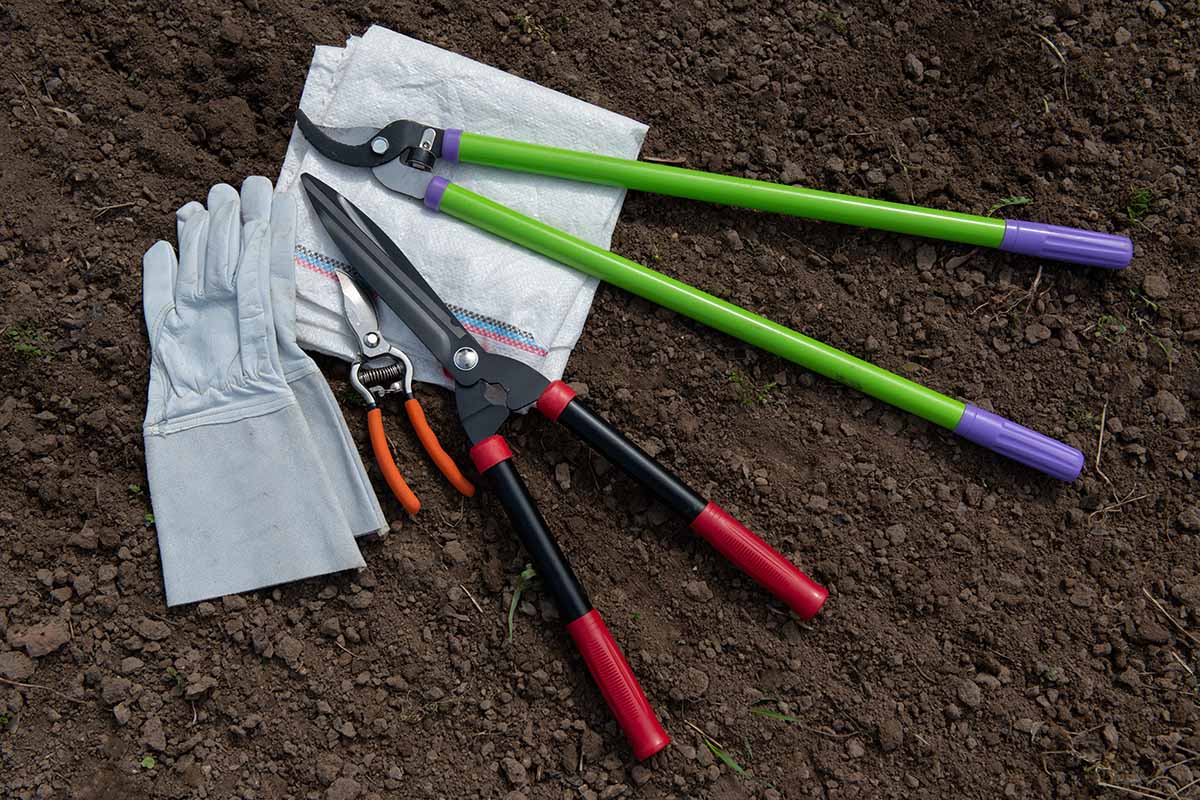
Overall, it is best to start the pruning process when trees are younger and easier to work with. You want to avoid significant pruning changes when the tree is older and solid in its structure.
You can cause willow trees to bleed sap if they are pruned at the wrong time. It is best to prune in the winter while the tree is dormant, to keep this to a minimum.
Make sure to use hand pruners for small stems and twigs. It is best to use long-handled loppers for bigger stems up to one and a half inches (four centimeters) in diameter.
They are efficient tools that make it possible to create cleaner cuts when leverage is needed. For anything larger, have a saw handy.
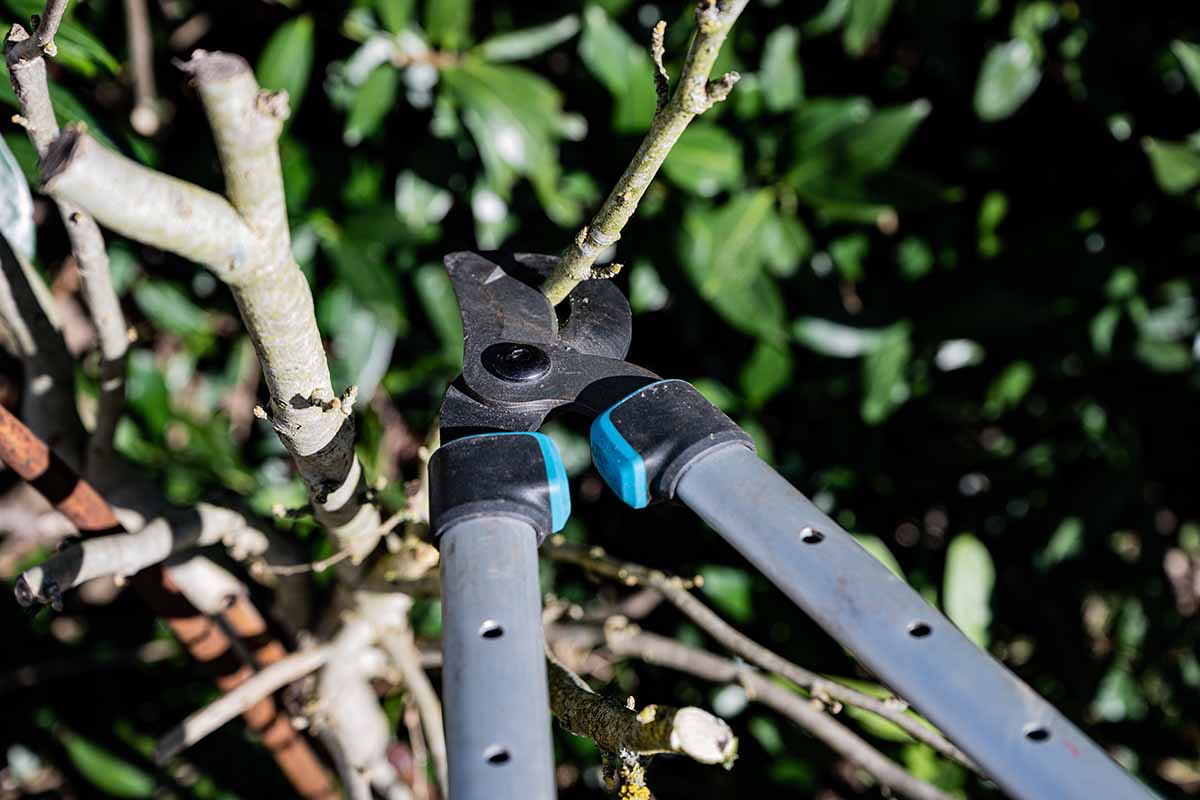
When pruning a young specimen, aim to remove weak branches and those that are broken, overcrowded, or growing too close together.
This helps to reduce the risk of disease problems and allows trees to heal faster. Weak branches will likely break when they become heavier.
While shaping your tree, you want to make cuts where a branch attaches to the trunk. If you need to shorten the branches, always cut before a leaf bud or twig; this encourages new growth. Be sure to remove any damaged or broken branches.
Removing branches from the bottom part of the trunk is recommended when the trunk reaches a diameter of two inches.
This common pruning practice is “limbing up” or “raising the crown.” This process raises the height of the canopy.
Removing the lower branches creates a clearance beneath the tree, which is beneficial if you want to mow, walk, or create a space for other plants or structures underneath.
Limbing up provides visual appeal by creating an open and well-defined trunk, which is desirable in some garden and landscaping designs.
Pruning improves airflow and light penetration within the tree’s canopy, and this helps with reducing the likelihood of fungal diseases.
Remove any branches that are growing upwards instead of out. This prevents breakage as the branch becomes heavy and the tree grows.
In general, mature specimens require no specific overwintering process. In the winter they naturally go through a dormant period, where they lose their leaves.
During this time, their energy is focused on the roots and main stem, which remains alive but dormant.
Keeping the mature plant well-watered until late fall and until the ground freezes hard is recommended. This ensures that it has sufficient moisture in its root system before dormancy.
Willow Tree Varieties to Select
There are many species and cultivars to choose from when growing a willow tree. Although I cannot list them all, here are a few of the most common species in cultivation:
Corkscrew
Favored for mysterious yet endearing twisting branches, S. babylonica var. matsudana (syn. S. matsudana, S. babylonica var. pekinensis) is native to northeastern China and grows in USDA Hardiness Zones 4 to 9.
It can grow up to 50 feet tall in full sun locations. This species will appreciate a part shade location in hot and arid regions.
This species stands out for its visually intriguing and unique form.
It features twisted, contorted branches that add texture and architectural appeal to the landscape even when devoid of leaves.
The cultivar ‘Tortuosa,’ commonly known as dragon’s claw, sports an upright growth habit, reaching a mature height of 20 to 30 feet and a spread of 10 to 15 feet.
Nature Hills Nursery carries three- to four- and four-to-five-foot-tall plants in #3 containers.
Peachleaf
With leaves that resemble those of peach trees, S. amygdaloides is native to various regions of North America and southern Canada and grows in USDA Hardiness Zones 3 to 5.
It attains heights of up to 40 feet and enjoys full sun to partial shade.
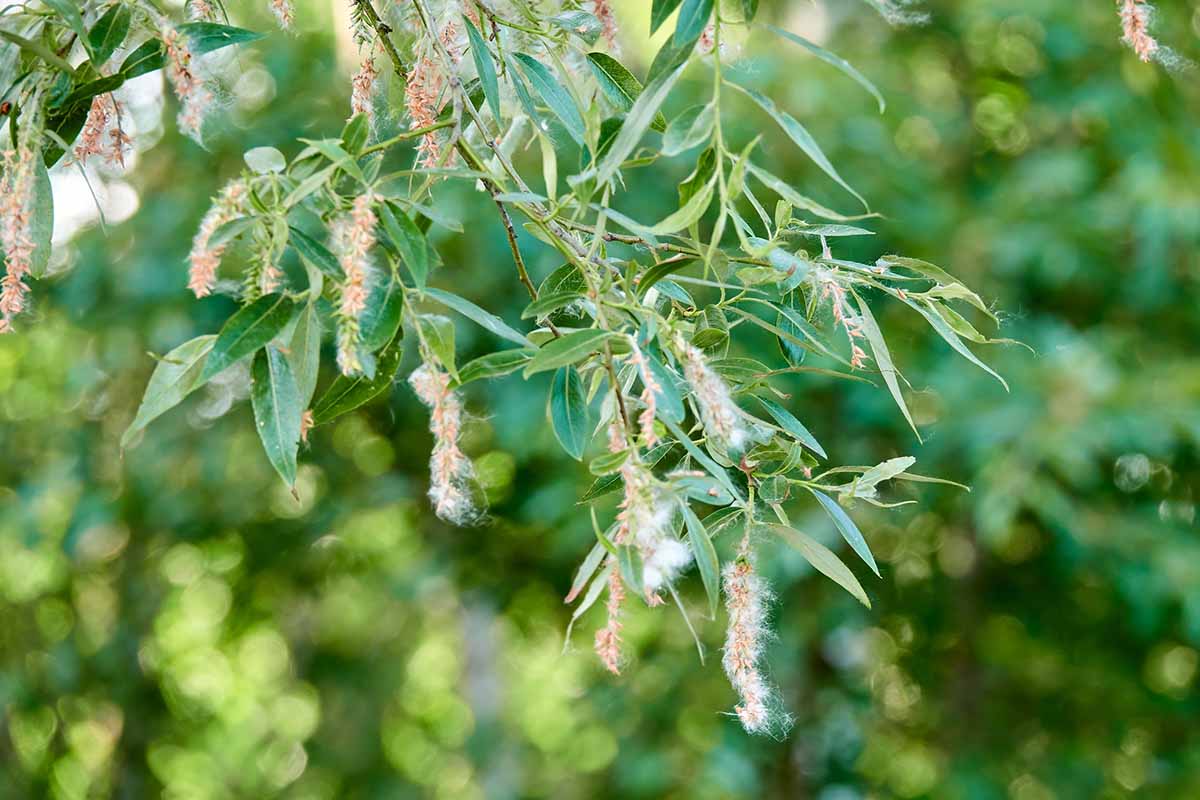
It is easily recognizable by its drooping branchlets, yellow twigs, and green leaves that are silvery white underneath and shimmer in a slight breeze.
This tree is typically a riverbank species that is found near swamps, creeks, lakes, swamps, and edges of wetlands.
Pussy Willow
Favored for its ornamental use, S. discolor is the perfect addition to your garden. They are loved for their welcoming blooms in the spring, making them a top pick for many gardeners.
Used for decorations during the lunar new year, it is thought to bring prosperity for that coming year. It is a popular pick amongst those who also use it for easter decorations.
S. discolor prefers full sun and can grow up to approximately 25 feet tall and wide. It is native to North America and grows in USDA Hardiness Zones 4 to 8.
Nature Hills Nursery carries one- to three-foot-tall S. discolor trees.
Weeping
Native to northern China, S. babylonica trees are well-known for their weeping habit. This species grows well on the edges of ponds and lakes.
The branches sway in the breeze, though stronger winds may break off stems and litter the ground. Plan to replace weeping willows in about 30 years as they are short-lived.
They grow in USDA Hardiness Zones 6 to 9, reaching heights of up to 50 feet, and they prefer full sun.
You can find S. babylonica available at Nature Hills Nursery in #3 containers.
Find more tips on growing weeping willows here.
White Willow
S. alba is known for its medicinal bark and is extremely large and fast-growing.
It is not the best tree for most landscaping situations because of its gigantic size and aggressive root system. It is sometimes used to fill low wet spots.
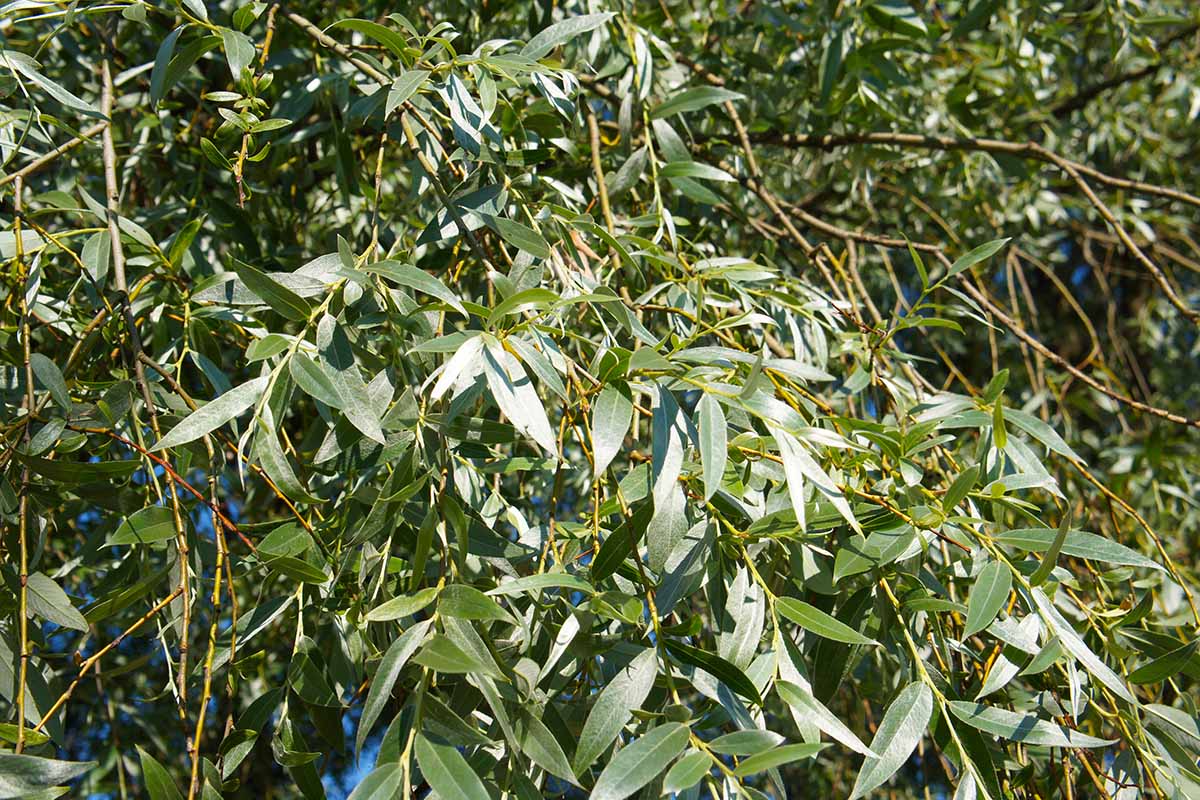
Native to western and central Asia and Europe, S. alba grows in USDA Hardiness Zones 4 to 9.
It prefers full sun to part shade and can reach heights of up to 100 feet.
Managing Pests and Disease
Like many other plants, willow trees can be susceptible to pests and disease. And like many gardeners, you may want to protect your precious trees from harm!
Here are some pests and diseases to look out for:
Herbivores
Whether they have cotton-like tails and twitching noses or a proud stature and mesmerizing pose, they can still do damage to your willow tree.
Rabbits
These cute little pests will hoppity-hop to gnaw on the stems and bark of young specimens and consume young shoots and buds of established trees.

Their feeding can result in bark stripping, girdling, or severed stem sections.
This can impede the flow of nutrients and water, compromising the health and even leading to the death of young or newly planted trees.
Removing large amounts of foliage can restrict the tree’s ability to photosynthesize and produce energy, stunting the tree’s growth.
The constant tampering with your tree can cause wounds or injuries and create entry points for disease-causing pathogens and other pests.
Some protective measures include fencing with mesh, applying commercial or homemade repellents with strong odors or tastes that rabbits find unpleasant, removing or minimizing rabbit-friendly habitats like dense brush piles, and humane traps.
Learn more about how to keep rabbits out of your garden in our guide.
Deer
When food sources are limited, deer are possibly coming for your willow. Particularly during winter, they may strip the bark from the lower trunk and branches.
This can expose the tree to diseases and pests, and cause girdling. Like our previously mentioned hopping buddies, their feeding can disrupt the flow of nutrients and water between the roots and the canopy.

During the rutting season, males rub their antlers against trees to mark their territory and strengthen their neck muscles. This can result in bark damage, wounds, and breakage of branches.
Some preventative measures that can be taken include installing tall, sturdy fencing, applying commercial and handmade deterrents, choosing deer-resistant varieties such as S. integra and S. matsudana, and creating a less inviting environment.
Learn more about how to manage deer in our guide.
Insects
Let’s take a look at some insect pests that are drawn to willow trees and how to manage an infestation.
Aphids
These soft-bodied vampire-like insects will sink in their fangs – or piercing-sucking mouthparts – to feed on the blood, I mean, plant sap of your willow.
They usually collect in colonies under the tender terminal growth in the spring. Leaves that are heavily infested can wilt, turn yellow, and senesce prematurely because of excess sap removal.
While the plant may look bad, they generally will not cause any severe harm to established trees. You may notice sooty mold as well, a fungal infection that can indicate an aphid infestation.
Read more about dealing with aphid infestations in our guide.
Cottonwood Leaf Beetles
Cottonwood leaf beetles (Chrysomela scripta) are pests that feast on willows both as adults and as larvae.
The larvae will skeletonize the leaves while the adults feed along the vein and the midrib. They are truly a powerhouse tag-team.
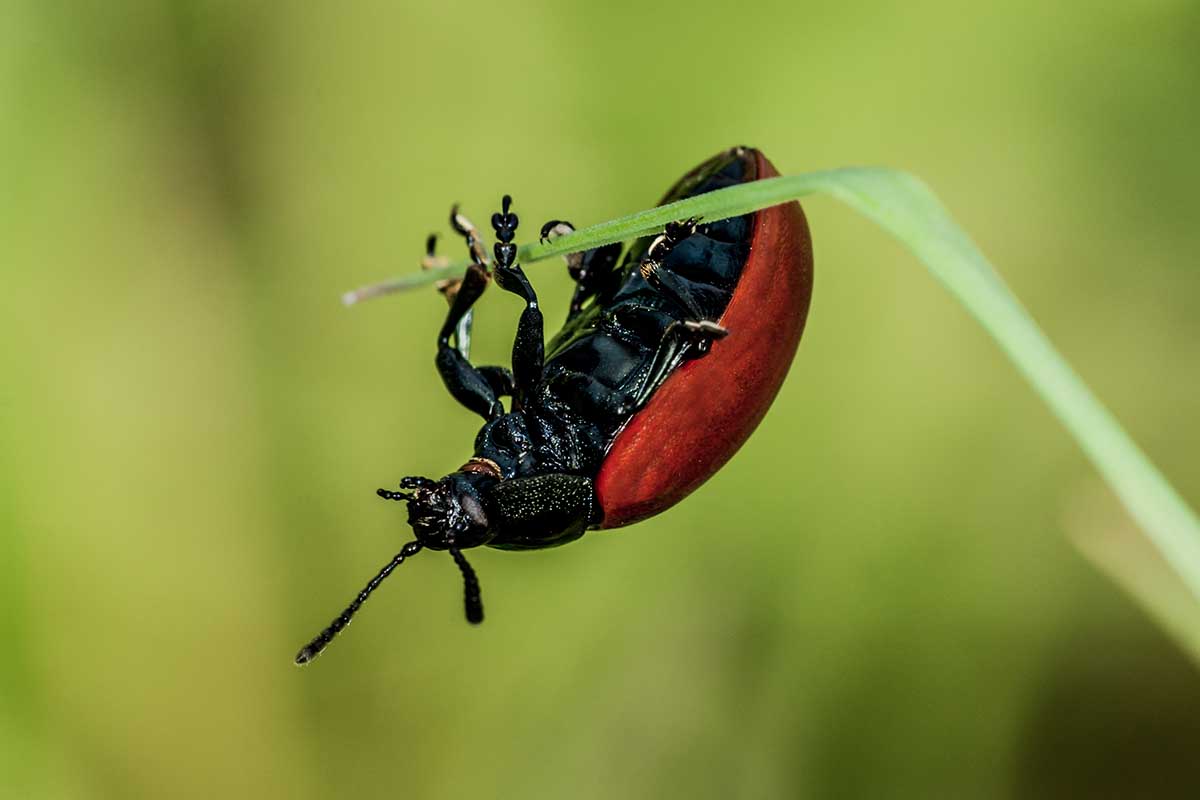
They produce multiple generations throughout the year, with damage occurring throughout the entire growing season. What a headache!
The larvae can tunnel around the crown and roots of the tree, which can damage young plants.
While the larvae themselves won’t kill mature specimens, this can make them susceptible to wind strikes if they’ve compromised a tree’s structure. They feed on leaves, shoots, and tender bark and can cause spotty tree damage.
Since these pests have few natural predators, many gardeners apply insecticidal soaps that can help control the larvae, such as those containing permethrin. This can prevent the adults from laying eggs and help to control the larvae.
Fall Webworms
Fall webworms (Hyphantria cunea) are caterpillar-like insects that will feed on many trees and shrubs, including your precious willow.
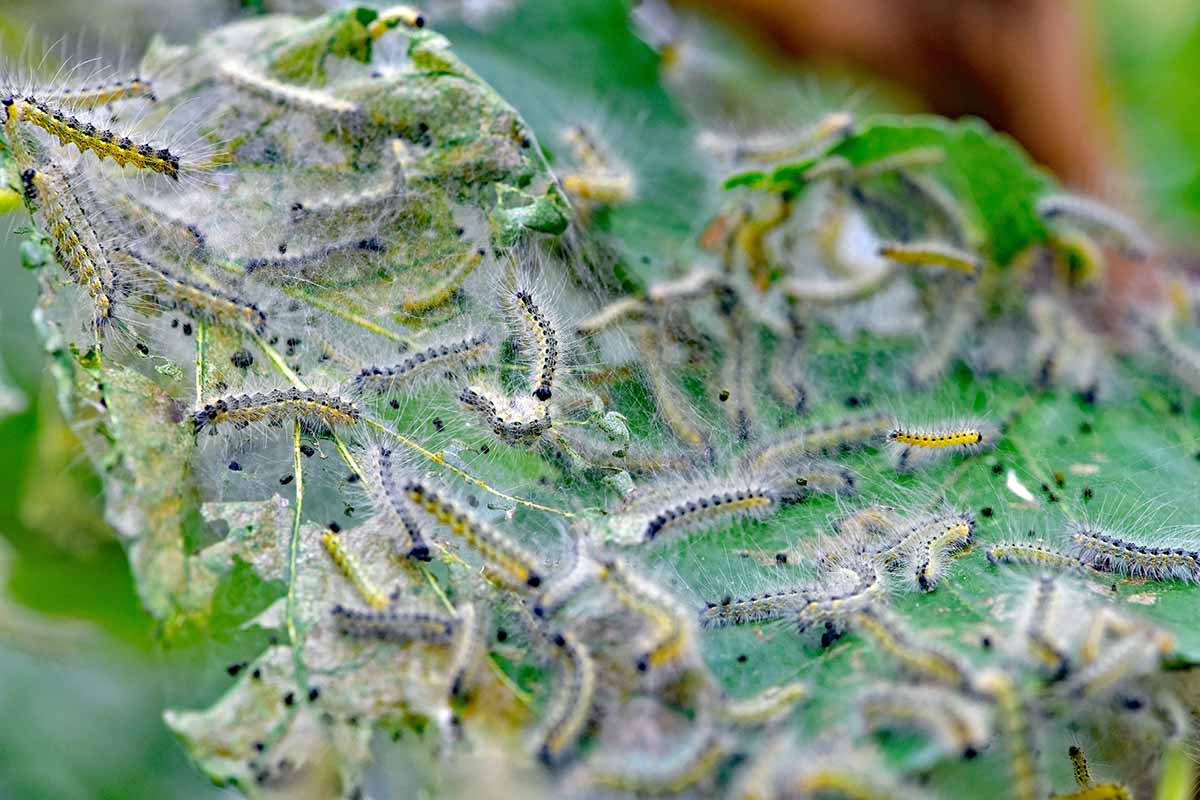
You will see their first generation active in May and their second in July.
They spend the winter pupating in the soil, waiting to feed on their host trees. They damage the tree’s appearance but this won’t usually affect the tree’s health.
Now, that’s good news!
Small numbers can be physically removed from plants if you’re able to reach and kindly placed into a pail of soapy water.
Or you may crush them on the plants if the kind method is too kind for you. Some even use a high-pressure water sprayer to knock them off.
Low-impact pesticides such as insecticidal soap and horticultural oil are effective when dealing with small numbers. Other pesticides that can be used are azadirachtin neem tree extract, and spinosad, which is derived from a soil bacterium.
Oystershell Scale
Oystershell scale (Lepidosaphes ulmi) pests commonly infest willows.
Heavy infestations can cause reduced vigor as the scale insects suck water and nutrients from the tree. They are powerful enough to kill limbs and sometimes entire trees in large numbers.
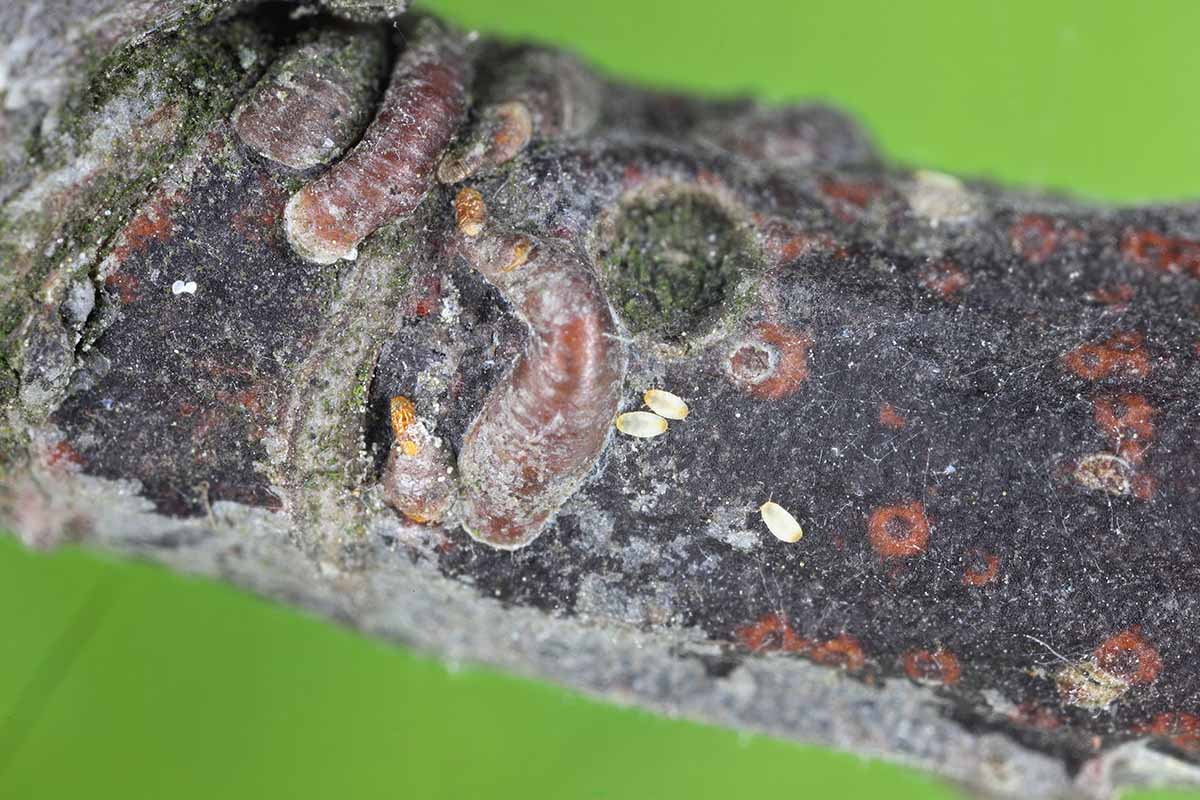
They are said to go through two generations of terror throughout the year. Lucky for us, natural enemies help to adequately reduce populations.
Scale can be physically removed from branches and stems with a plastic dish scrubber if you find them. Try not to damage the thin bark on the trees. Many gardeners use horticultural oil or other types of insecticides.
Note that chemical insecticides are only effective against these pests in the crawler stage.
Mite Galls
Several different mite species cause galls on willow trees through their salivary secretions.
Galls may also be caused by mite excretions, secretions from developing larvae, or mite presence in or on plant tissue.
Some species include the catkin gall mite (Aculus tetanothrix), rust mite (Aculops salix), and bud gall mite (Aculops minimus).
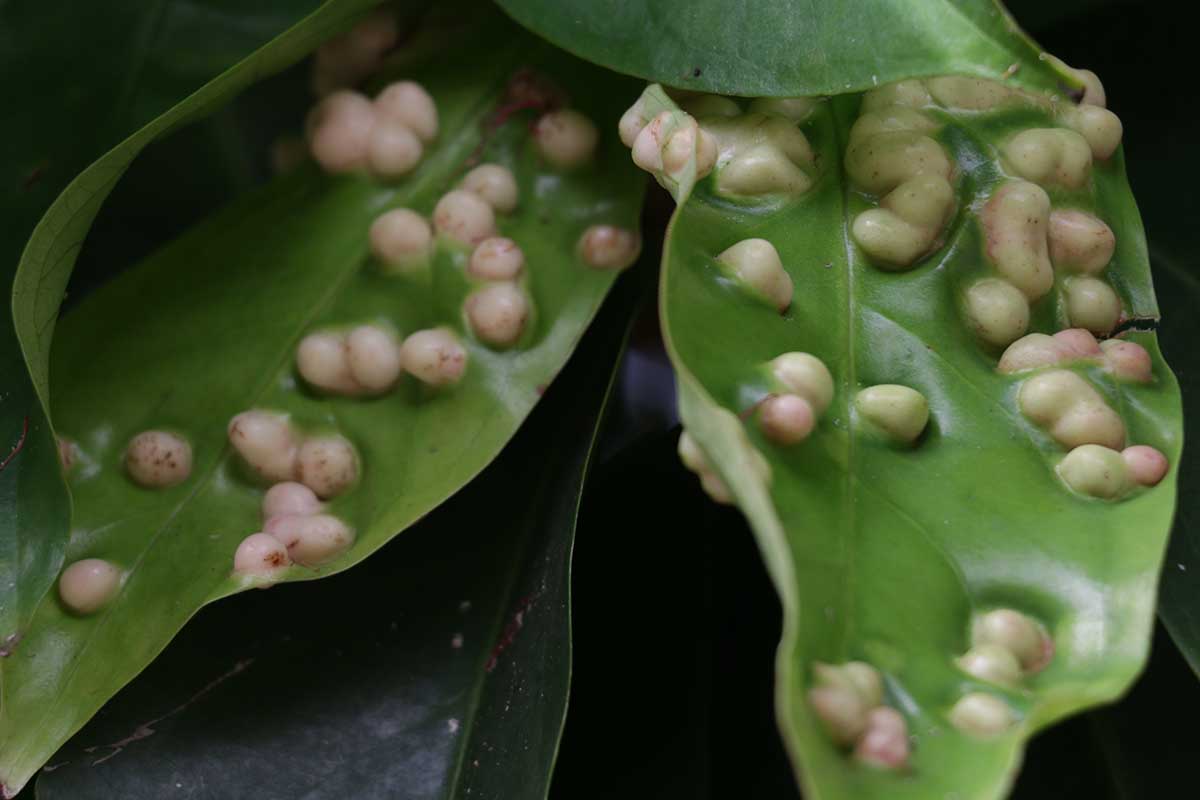
You need to cut off any infected areas to get rid of the galls. Wherever you see any blistering of the leaves or excessive growth of hairs, that’s a sign of mites.
Lady bugs can be used to feed on these mites, and they will get rid of them quickly. All hail, ladybugs! It is an extra bonus that ladybugs don’t harm your plants.
Some other options are dormant spray oil, green lacewings, and insecticidal soap.
Disease
Let’s take a look at some of the common diseases that can plague willow trees. As if these trees didn’t have enough predators to deal with already. What a cost to be so lovely…
Black Canker
Black canker is caused by Glomerella miyabeana. This fungus causes lesions on the leaves that will lead to defoliation and as the pathogen spreads, will cause cankers to form in between the branches and twigs.
Pruning away any infected leaves, twigs, and branches is vital to treating this disease. Although you can’t cure existing cankers with fungicide, you can prevent reinfections.
Many use Chlorothalonil fungicide to control further spread, but applications must be timed properly.
Crown Gall
This disease commonly affects willow trees. It is caused by a bacteria called Agrobacterium tumefaciens, which creates gall-like tumors on the tree’s roots or bark.
There is sadly no cure for crown gall, but if you follow proper management practices, your willow can survive. Copper-based fungicides can slow down disease progression.
Quick Reference Growing Guide
| Plant Type: | Deciduous tree | Flower/Foliage Color: | Green/green (yellow in fall) |
| Native to: | North America, Europe, and Asia | Water Needs: | Moderate to high |
| Hardiness (USDA Zones): | 4-9 | Maintenance: | Low-high, depending on variety |
| Bloom Time/Season: | Spring-summer | Tolerance: | Wet conditions, various soil types, temperatures, and light conditions, pollution |
| Exposure: | Part to full sun | Soil Type: | Loamy |
| Time to Maturity: | 15-20 years | Soil pH: | 5.5-8.5 |
| Spacing: | Depends on mature size | Soil Drainage: | Moist/wet |
| Planting Depth: | 6-8 inches (cuttings), 1/4 inch(seed), depth of root ball (transplants) | Attracts: | Birds and other wildlife, bees and other flying insects, wetland species |
| Height: | 20-140 feet, depending on variety | Uses: | Medicine, ornamental, timber |
| Spread: | 30-60 feet, depending on variety | Family: | Salicaceae |
| Growth Rate: | Depends on species | Genus: | Salix |
| Common Pests and Disease: | Aphids, caterpillars, gall midges, gall mites, leafhoppers, leaf miners, scale, sawflies, bark beetles, borer beetles, leaf beetles, sawflies; bacterial canker, crown gall, fire blight, leaf spot, powdery mildew, rust, slime flux, verticillium wilt | Species: | Alba, amygdaloides, babylonica, caprea, discolor, exigua, integra, lutea, matsudana, nigra |
Sow and Grow, Fellow Willow
And there you have it, fellow tree enthusiasts! We’ve reached the end of this whimsical willow tree adventure.
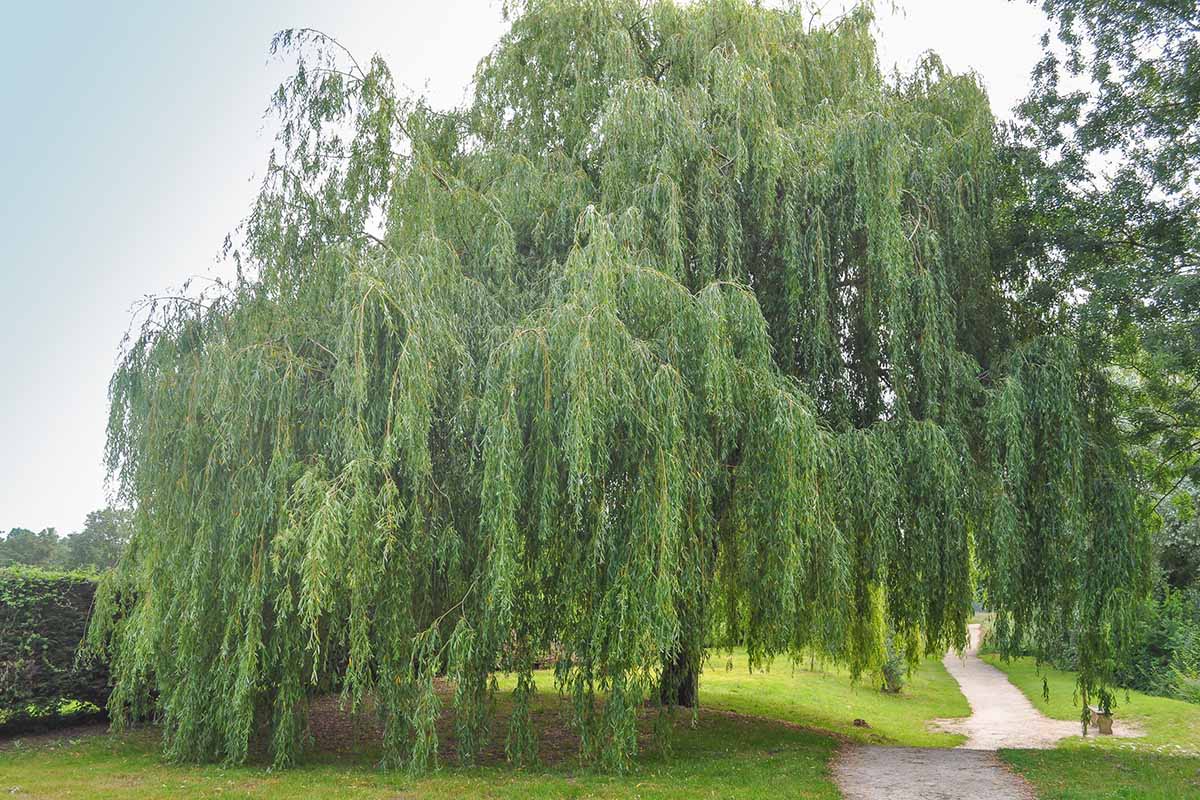
Now armed with techniques, tips, and the sheer excitement of growing your own willow tree, it’s time to roll up those sleeves, grab your gardening tools, and let the magic unfold! May your willow trees grow strong!
We would love to hear about your willow tree growing journey. Feel free to share your experiences with us in the comment section below.
If you are interested in learning more about other landscape trees that you can grow at home, check out these articles next:
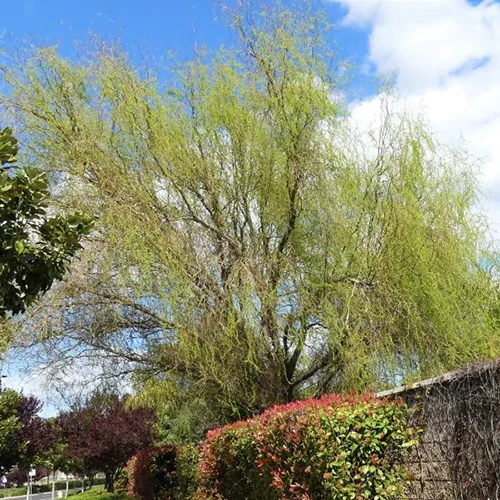
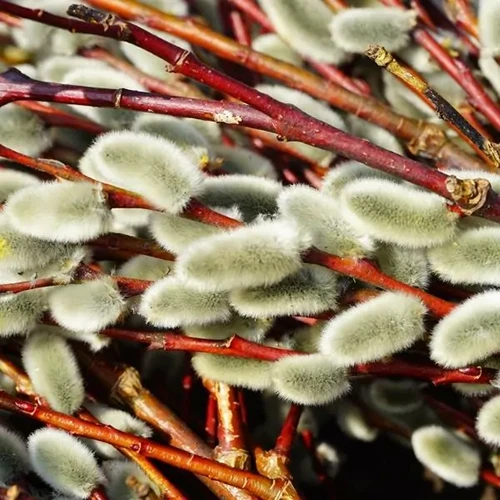
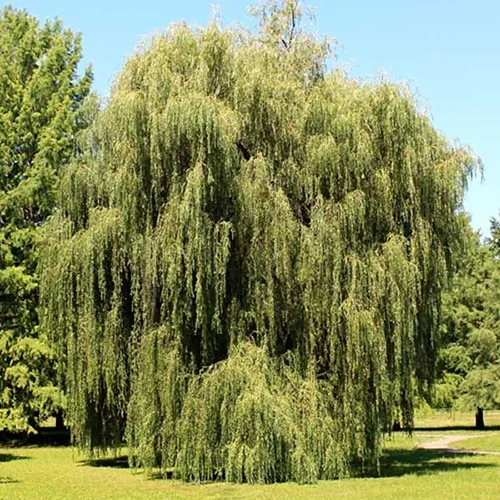
Thanks for your valuable advice.
Thanks for reading Amitva, glad it was helpful!